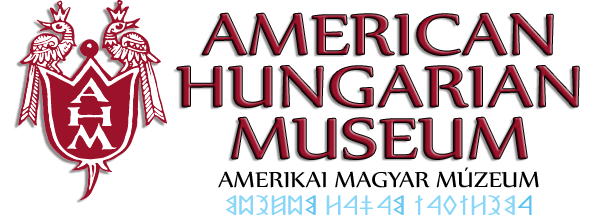HUNGARIAN INVENTORS I
Írta és összeállította:
Kerkayné Maczky Emese
Angolra fordította/translated by:
Bányai Bíbor
Felsővályi Klára
Kertész Kinga
Papp Tamás
Sziráki Dorottya
Tála Teréz
Rajzolta/Drawings by:
Benkő Andrea Veronika
Kiadta/Published by:
SZENT ISTVÁN MAGYAR ISKOLA
Passaic, New Jersey, 2000
INTRODUCTION
Hungarians are talented people with great knowledge, spreading it
throughout the world for a long time. It was a project of the older students
of Saint Stephen Hungarian School to learn more about the thousands of
Hungarian inventions. Over the years we collect ed 180 pages of data about
20 inventors. However, during our research we noticed with great
astonishment, that – apart from the Nobel Laureates – the Hungarian
inventors do not exist in the English language literature. The encyclopedias
treat the Hungarian genius with great silence. This urged us to research
even more seriously. The idea to translate the short sum maries into English
and publish them was the next logical step.
It was an extremely difficult task for the 14 years old students
to translate the Hungarian text full with technical terms. They passed this
hurdle with excellence. I have to mention the diligence and persistence of
Dorottya Sziráki who never gave up and without whom the work never would
have been finished. We are grateful to Andrea Veronika Benkő for the
wonderful portraits and cover page, which illustrations were her
contribution to this project.
Naturally the presented material is only a small portion of the
immense knowledge with which the Hungarians enriched humanity. With this
modest work our school would like to contribute to the huge task of making
known to the world the Hungarian mind, a bottomless well of knowledge, which
the world ignores.
Passaic, May 15, 2000
Emese Kerkay
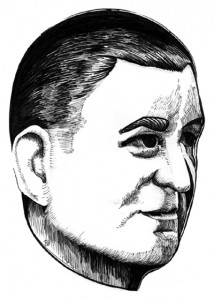
ASBÓTH OSZKÁR (1891 – 1960)
Invention: HELICOPTER
Oszkár Asbóth was born in Pankota and died in Budapest. He finished
his stud ies at Arad and became an engineer. He was a student of Tódor von
Kármán, the Father of Supersonic Flight.
In 1917, during World War I, Oszkár Asbóth, Tódor von Kármán, István
Petróczy and Vilmos Zurovetz worked together on designing the helicopter.
After many years of experimentation following the war, he built the
Asbóth-helicopter. On September 9, 1928, witnessed by many foreign experts,
his model „AH 1” heli copter ascend ed from a standing position vertically
to a great height for the
FIRST TIME IN THE WORLD.
Liptrot from the British Air Ministry, who travelled on the
helicopter, wrote in a Journal of the Aeronautical Society in 1931:
the Asboth-helicopter ascends vertically with a remarkable speed… to any
height where it can hover stationary for some time. It can be perfectly
navigated. But the most remarkable is that, unlike other tested
helicopters, this one remains absolutely stable around all axes…
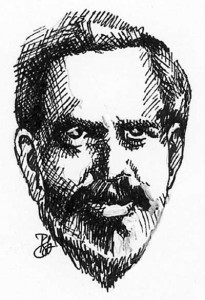
BÁNKI DÓNÁT (1859 – 1922)
Inventions:
BÁNKI-CSONKA PETROL ENGINE
CARBURETOR
FRONTWHEEL RUNNING CAR
WATER TURBINE
With JÁNOS CSONKA, creator of
Hungarian automobile manufacturing
Dónát Bánki was born in Bánk and died in Budapest. He studied
mechanical engineering in Budapest. From 1899 to his death he taught at the
Technical University in Budapest.
In 1892, before Diesel, Dónát Bánki created the first great
compression, low consumption gasoline engine, the Bánki-motor.
In 1892, Dónát Bánki and János Csonka invented the carburetor for
their gasoline engine. Even though their invention went through some
changes as time passed, every modification was based on this invention.
In 1917, Bánki invented the water turbine, which was useful for
utilizing the energy of small and medium sized waterfalls.
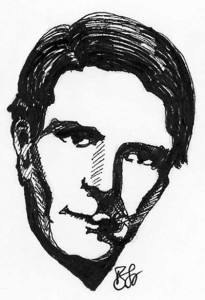
BAY ZOLTÁN (1900 – 1992)
Inventions:
LUNAR – RADAR
GLOWING FLUORESCENT LIGHTS
DEVELOPER OF RADAR ASTRONOMY
Zoltán Bay was born in Gyulavár and died in Washington D.C. He studied
in Debrecen, at the Pázmány Péter University of Sciences in Budapest, where
he received his Ph.D. degree, and in Berlin. In 1930 he became professor of
physics at the University of Szeged.
Zoltán Bay, the world renown physicist, was the first to perform the
following experiment, as a research engineer of the Standard Factory in
Budapest, in 1943: he sent ultra-short radio waves to the moon, which,
reflected from there worked as a radar, and could be used to measure
distance, as well as to study the moon.
He was engaged in the development of television as early as 1936.
In 1948, he left Hungary, and became professor of the Physics
Department at the George Washington University in Washington. After he
retired, he continued his research activity till the end of his life. It is
unbelievable, that this great scientist didn’t receive a Nobel prize.
Two years before he died, he wrote his autobiography, titled Az élet
erősebb (Life Is Stronger). His remains were buried in Gyulavár, the place
of his birth.
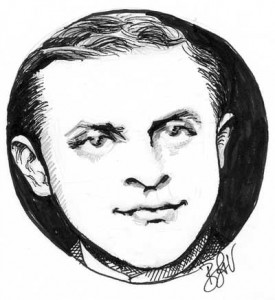
BÍRÓ LÁSZLÓ JÓZSEF (1899 – 1985)
Inventions:
BALLPOINT PEN
AUTOMATIC SHIFT
STEAM POWERED WASHING MACHINE
more than 30 internationally
recognized inventions
József László Bíró was born in Budapest and died in Buenos Aires,
Argentina. He first studied medicine, but Biró was a many sided person.
Between 1921 and 1938, he was a journalist, sculptor, painter, art critic,
stock broker, hypnotizer, race-car driver, car salesman and of course an
inventor.
József László Biró’s most famous invention was the ballpoint pen. By
1938, he had patented it in over 100 countries. Finally in 1948 the Parker
Company bought his patent. In the USA it became known as the BIRÓ PEN.
His other important invention was the automatic gear shift. In 1932,
he traveled with his engineer friend Rigó from Budapest to Berlin (more
than 1000 km = 625 mi) on a motorcycle with a sealed gear shift. General
Motors bought his patent, just so the competition wouldn’t be able to buy
it.
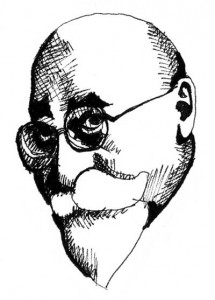
BLÁTHY OTTÓ TITUSZ
(1860 – 1938)
Inventions:
TRANSFORMER
WATT METER
Ottó Titusz Bláthy, mechanical engineer, was born in Tata, and died in
Budapest. He graduated from the Technical University in Vienna.
He invented the transformer with Miksa Déri and Károly Zipernowsky. At
Blathy’s suggestion they constructed it with a closed iron core. At that
time the transformer was the most important invention in electronics.
Bláthy had more than 100 inventions. He was the first to join the
thermal power plant with the hydraulic power plant.
Another important invention of his was the Watt Meter, which was named
after him. Many similar mechanisms existed, but only Bláthy’s worked. All
Watt meters used today are based on his invention.
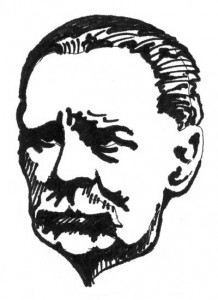
CSONKA JÁNOS
(1852 – 1939)
Inventions:
CARBURETOR
AUTOMATIC TUBE IGNITION
(for petrol engines)
GAS ENGINE
MOTORTRYCICLE (for mailmen)
GASOLINE MOTOR CAR
Creator of the Hungarian
automobile industry
János Csonka, inventor, was born in Szeged and died in Budapest. From
1875 he was head of the training shop at the Technical University in
Budapest.
In 1879 he constructed a four-cycle gas engine according to his own
ideas, which was the first Hungarian combustion engine.
During 1892 and 1893 János Csonka and Dónát Bánki invented the
carburetor for the Bánki-Csonka engine. Csonka and Bánki made new headways
with the engines they constructed. They made Hungary independent from the
solutions of foreign factories, which still struggled with ways inherited
from steam engines.
Csonka’s main expertise was engine manufacturing. Among many things,
he invented the regulating mechanism for the inner combustion engines, a
mechanism for forced automatic settings of the ignition for combustion
engines. He also patented a portable chain saw equipment which could be
disassembled for easy transportation.
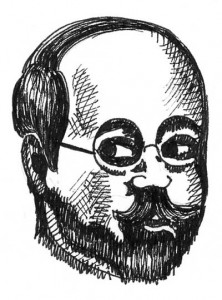
DÉRI MIKSA
(1854 – 1938)
Inventions:
TRANSFORMER
REPULSION MOTOR
Miksa Déri was born in Bács and died in Merano. He acquired his diploma
in mechanical engineering in Vienna.
Miksa Déri, together with Ottó Bláthy and Károly Zipernowszky became
world famous with the invention of the alternating electric transformer
system. This system made it possible to send electric energy to great
distances and divide it over large areas. Today, there is hardly any large
energy producer, which isn’t based on this system. The experimentation was
mainly done by Déri.
He had many other inventions also. The Déri-repulsion motor is one of
them. With it, elevators could be safely used. This had not been achieved by
any other type of motor until then.
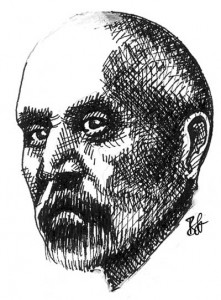
báró EÖTVÖS LORÁND
(1848 – 1919)
Inventions:
GRAVITATIONAL TORSION BALANCE
EÖTVÖS UNIT OF GRAVITATION
LAW OF CAPILLARITY
The University of Science in Budapest
was named after Baron Loránd Eötvös.
Dr. Baron Loránd Eötvös, physicist, professor, minister of education,
was born in Buda and died in Budapest. He completed his education in
Heidelberg, Germany.
The Torsion or Eötvös balance, designed by Baron Eötvös, is a
sensitive instrument for measuring the density of underlying rock strata.
The device measures not only the direction of force of gravity, but the
change in the force of gravity’s extent in horizontal plane. It determines
the distribution of masses in the earth’s crust. The Eötvös torsion
balance, an important instrument of geodesy and geophysics throughout
the whole world, studies the Earth’s physical properties. It is used for
mine exploration, and also in the search for minerals, such as oil, coal
and ores.
Eötvös’ law of capillarity served as a basis for Einstein’s theory of
relativity.
(Capillarity: the property or exertion of capillary attraction of
repulsion, a force that is the resultant of adhesion, cohesion, and surface
tension in liquids which are in contact with solids, causing the liquid
surface to rise – or be depressed…)
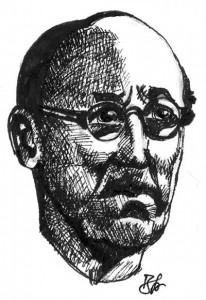
FONÓ ALBERT
(1881 – 1972)
Inventions:
JET
TORPEDOES
Dr. Albert Fonó was born and died in Budapest. He studied mechanical
engineering at the József Technical University in Budapest and continued
his studies abroad with a scholarship.
His theoretical work was many-sided. His main field was energetics.
His first invention – in 1915 – was an aerial torpedo, which worked
with jet propulsion and would have increased the effectiveness of
artillery. Its significance was not recognized and understood by his time.
In 1923 he patented a new prototype of the gas boiler (furnace) and in
1928 an air compressor for mines.
His most important invention was a jet propulsion engine for supersonic
aircrafts. After four years of preliminary examination, it was patented in
Germany in 1932. With his invention he proved himself ahead of his time.
He became a corresponding member of the Hungarian Academy of Sciences
in 1954; from 1965 he was a corresponding member of the International
Academy of Astronautics.
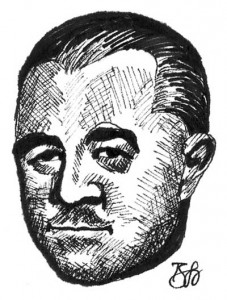
GALAMB JÓZSEF
(1881 – 1955)
Inventions:
DESIGNER OF THE
FORD MODEL-T CAR
PLANETARY GEARBOX
IGNITION PLUG
FORDSON TRACTOR
József Galamb was born in Makó Hungary and died in Detroit. He
graduated in Budapest in mechanical engineering.
József Galamb, as the employee of the Ford Company, designed the famous
Model-T car. He invented the planetary gearbox and the electrical ignition
system (spark plug). At the same time, he designed the mass production of
cars. The small Ford Company became a huge factory. In 19 years, they made
15 ½ million Model-T cars.
József Galamb also designed the elegant Model-A car.
During World War I, he designed the Fordson tractor. The English
government ordered 7000 pieces of this model. The farmers were very fond
of this tractor because it was lighter than the other available tractors
and handling it was also much easier. In 1925, more than half of the
tractors made in the USA were manufactured by the Ford Company.
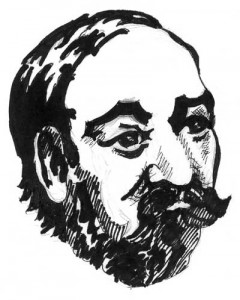
IRINYI JÁNOS
(1817 – 1895)
Invention:
MATCHES
János Irinyi, a chemist, was born in Nagyléta and died in Vértes. He
completed his education in Vienna and in Hohenheim, Germany.
Many experimented with the lighting of fire, but they only came up with
complicated and dangerous solutions. In 1836, Irinyi invented a match,
which was neither dangerous, nor unhealthy.
He dissolved phosphorus in water and shook it in a glass foil, until
it became granulated. He mixed the phosphorus with lead and gumiarabicum,
poured the paste-like mass into a jar, and dipped the pine sticks into the
mixture and let them dry. When he tried them that evening, all of them
lighted evenly.
He had invented the MATCH!
István Rómer, a rich Hungarian pharmacist living in Vienna, bought the
invention and production rights from Irinyi, the poor student, for 60
Forint. The production of matches began, and everybody was happy throughout
the world. István Rómer became rich off Irinyi’s invention, but Irinyi
himself died poor and abandoned in Vértes.
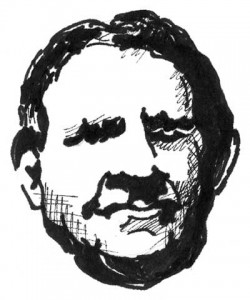
JEDLIK ÁNYOS
(1800 – 1895)
Inventions:
ELECTROMOTOR
DYNAMO
Dr. Ányos Jedlik, a Benedictine monk, scientist and inventor, was born
in Szimő and died in Győr. He completed his education in Győr and Pest.
In 1828, 18 years before Siemens, Ányos Jedlik constructed the first
electromotor in Győr. He invented the dynamo in 1861. He did not patent his
inventions, nor did he sell them. He was satisfied with knowing that his
machines worked. He taught his theories and inventions at the university in
Hungary. However, the world didn’t know about them. Several years later,
Siemens invented both of these machines, and both were named after him.
The first electromotor, built in 1828, and Jedlik’s operating
instructions are kept at the Museum of Applied Arts in Budapest. The motor
still works perfectly today.
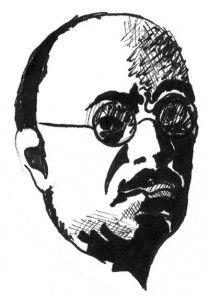
KANDÓ KÁLMÁN
(1869 – 1931)
Inventions:
PHASE-CHANGING
ELECTRIC LOCOMOTIVE
ELECTRIFICATION OF RAILWAYS
Kálmán Kandó was born in Buda and died in Budapest. He studied
mechanical engineering at the Technical University of Budapest. He was
the pioneer of railway-electrification.
Kandó’s main invention is, that three-phase alternating current can be
used for the hauling of large trains.
His most marvelous invention is the phase-changing electric locomotive,
which was named Kandó-locomotive after him. The Kandó-locomotives are used
in many countries of the world. This revolutionary invention transforms
standard public utility (single-phase) current into three-phase alternating
current in the locomotive and therefore makes it capable of hauling.
The electric railways in Northern Italy and the section of the
Hungarian State Railways between Budapest–Hegyeshalom– Vienna (1929) were
built based on Kandó’s invention.
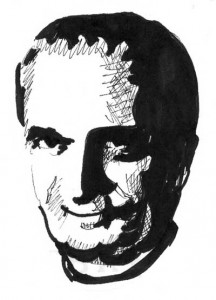
KÁRMÁN TÓDOR
(1881 – 1963)
FATHER OF SUPERSONIC FLIGHT
ARCHITECT OF THE SPACE AGE
(United States Postal Service 1991)
Tódor von Kármán, a leading theoretician in aerodynamics, was born in
Budapest and died in Aachen, Germany. After graduating in mechanical
engineering at the Technical University in Budapest, he went to study in
Göttingen on a scholarship. He received there his Ph.D. degree and became a
professor till 1912.
During World War I. he was chief of research in the aviation corps of
the Austro-Hungarian army. There, with his colleagues he developed the
world’s first military vehicle with rotating blades, the PKZ-type
helicopter. After the war he was one of the founders of the German Luftwaffe
and adviser to the Junkers airplane company.
In 1929, he was invited to the United States, and in 1930, became
director of the Guggenheim Aeronautics Laboratory at the California
Institute of Technology. After World War II. he was one of the founders of
the JET Propulsion Laboratory for space research. He was a scientific
advisor worldwide in the fields of aerodynamics, aeroplane design,
aeronautics, astronautic and space flight. Kármán had a leading role in the
development of the B-36, B-47 and B-52 aircrafts, the Atlas, Titan and
Minuteman rockets.
As recognition for his work craters on the Moon and Mars were named
after him.
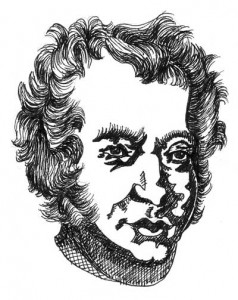
KEMPELEN FARKAS
(1734 – 1804)
Inventions:
SPEAKING MACHINE
recorded and imitated human speech
TYPEWRITER for the blind
STEAM TURBINE
ELEVATOR FOR PEOPLE
for the palace of Schönbrunn
SELF-REGULATING PUMP
for the fountains of Schönbrunn
CHESS AUTOMATON
This was his most peculiar invention, with which he astonished everyone.
This machine defeated all the chess players of the world. Nobody could
solve its secret. The chess playing machine was destroyed by fire in
Philadelphia, and the way it worked remained a mystery forever.
Farkas Kempelen, counsellor of the royal chancellery, mechanic,
scientist, inventor, was born in Pozsony and died in Vienna. He studied
law and philosophy in Győr and Vienna. His talents were extraordinarily
versatile.
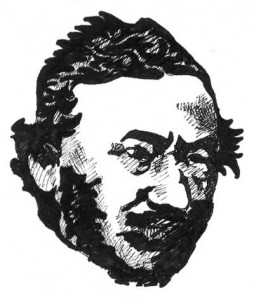
PETZVAL JÓZSEF
(1807 – 1891)
Inventions:
ACHROMATIC PORTRAIT LENS
DARK ROOM
PROJECTOR
József Miksa Petzval was born in Szepesbéla and died in Vienna. He
became an engineer at the Institutum Geometricum in Pest and later received
a Ph.D. degree in mathematics. He taught mathematics and mechanics at
the Universities of Pest and Vienna.
In Petzval’s time, two French scientists invented photography. The
luminosity of the optical lens was so weak that taking pictures of persons
was impossible because it took at least 30 minutes. In 1840 Petzval designed
a double lens, that reduced the time of taking a picture to seconds. The
first lens was cut by Voigtländer, a German optician, according to the
calculations and directions of Petzval. This lens made portrait
photography possible and became the basis of the photographic industry.
A large camera factory under the name of Voigtländer is still operating
in Germany. Nobody mentions the name of Petzval. The same thing happened
to him as to Ányos Jedlik.
Petzval built the first dark room.
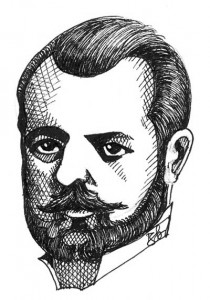
PUSKÁS TIVADAR
(1844 – 1893)
Inventions:
TELEPHONE EXCHANGE
TELEPHONOGRAPH
(Speaking Newspaper)
Tivadar Puskás was born in Pest and died in Budapest. He studied in
Vienna. According to Edison „Tivadar Puskás was the first man in the world,
who thought about a telephone exchange”.
In 1878, he built the first telephone exchange in Boston, then he built
one in Paris and Budapest. On Bell’s telephone one person could talk to one
other person only. Tivadar Puskás invented the multiple switch box, which
made any number of phone users’ connection or disconnection possible.
The telephonograph (speaking newspaper) transmitted news and music
programs, using the telephone network. From 1893, 20 years before the
invention of the radio, people could listen to news and music in Budapest
daily. They could enjoy direct broadcastings from the Opera house.
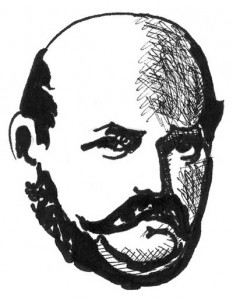
SEMMELWEIS IGNÁC
(1818 – 1865)
He discovered the
CAUSE OF PUERPERAL (CHILD BED)
FEVER: INFECTION!
DISINFECTION WITH CHLORINATED WATER STOPS DEATH
THE SAVIOR OF MOTHERS!
Doctor Ignác Semmelweis was born in Buda and died in Vienna. He studied
in Pest and Vienna.
In Vienna, he worked in the maternity ward and saw in dismay how many
mothers and children die during birth. He soon realized that the cause was
infection, which the doctors spread from one mother to the next. He
discovered that this could be stopped if doctors wash their hands with
chlorinated water before they touch the mothers. The doctors working
around him ridiculed him. In 1850 he went back to Budapest, where he became
head physician of the maternity ward of the Rokus Hospital. By using his
methods – hygiene – puerperal fever was almost completely eliminated in
his clinic in Pest.
“After an autopsy, we must wash our hands, otherwise we spread poisonous
death.”
Dr. Ignác Semmelweis
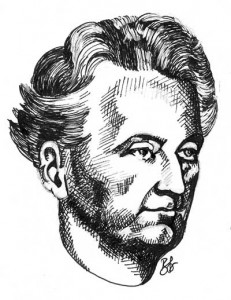
SZENT-GYÖRGYI ALBERT
(1893 – 1986)
Invention:
ASCORBIC ACID or VITAMIN C
Albert Szent-Györgyi was born in Budapest and died in Woods Hole, MA,
USA. He completed his studies in Hungary, Germany, Holland and England. He
received his doctorate in medicine at the University of Science in
Budapest and his second Ph.D. in chemistry in Cambridge. From 1930 to 1945
he was professor of medicinal chemistry at the University of Szeged.
Albert Szent-Györgyi won the Nobel Prize in Medicine in 1937 for his
discoveries in connection with the biological combustion process,
especially in reference to vitamin C and the catalyst of fumaric acid.
Szent-Györgyi discovered that vitamin C is abundant not only in citrus
fruits but in Hungarian paprika as well.
Vitamin C has an important role in maintaining good health, such as
strengthening the immune system, in the prevention of heart disease,
certain forms of cancer, allergic symptoms, colds and influenza, etc.
From 1947 until his death Szent-Györgyi lived and worked in the United
States. He researched the biochemistry of muscular action and the causes of
cell division. He also took active part in cancer research.
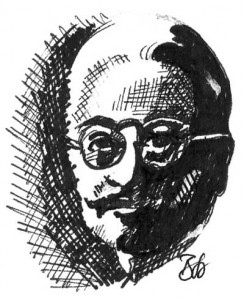
ZIPERNOWSKY KÁROLY
(1853 – 1942)
Inventions:
TRANSFORMER
MULTI PHASE CURRENT
DISTRIBUTION SYSTEM
BAYONET-LOCKED LAMP SOCKET
COHERER
Károly Zipernowsky was born in Vienna and died in Budapest. He started
as a pharmacist. Later he graduated as a mechanical engineer in Budapest.
He invented the transformer together with Ottó Bláthy and Miksa Déri.
They also developed the alternating current distribution system based on
the transformer connected in parallel.
The coherer (radio conductor) was a vital component of the old radio.
Coherer means: waves having a constant phase relationship.
He was fascinated with electrotechnology. As a student, he gave many
lectures in this field. At age 25 he was invited by the CEO of the Ganz
factory to organize the electrical department. Under his leadership, Ganz
Villamossági M_vek became Europe’s first large-scale electrical factory, and
soon after, it was recognized worldwide.
Zipernowsky was a many-sided inventor. He wrote a book: Saját és
másokkal szabadalmaztatott találmányaim (My own and jointly patented
inventions). In this book he describes 40 of his inventions.
